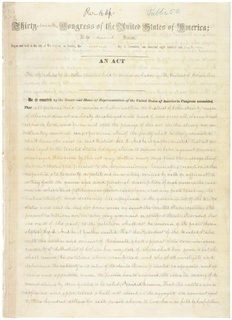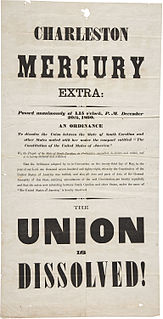 W
WAn Act for the Release of certain Persons [Black slaves] held to Service or Labor within the District of Columbia, 37th Cong., Sess. 2, ch. 54, 12 Stat. 376, known colloquially as the District of Columbia Compensated Emancipation Act or simply Compensated Emancipation Act, was a law that ended slavery in the District of Columbia, providing slave owners partial compensation for releasing their slaves. Although not written by him, the act was signed by U.S. President Abraham Lincoln on April 16, 1862. April 16 is now celebrated in the city as Emancipation Day.
 W
WThe Emancipation Proclamation, or Proclamation 95, was a presidential proclamation and executive order issued by United States President Abraham Lincoln on September 22, 1862, during the Civil War. The Proclamation read:That on the first day of January in the year of our Lord, one thousand eight hundred and sixty-three, all persons held as slaves within any State, or designated part of a State, the people whereof shall then be in rebellion against the United States shall be then, thenceforward, and forever free; and the executive government of the United States, including the military and naval authority thereof, will recognize and maintain the freedom of such persons, and will do no act or acts to repress such persons, or any of them, in any efforts they may make for their actual freedom.
 W
WGeneral Order No. 3 was a general order which transmitted the news of the Emancipation Proclamation to the residents of Texas and freed all remaining enslaved people in the state. It was issued by Union General Gordon Granger on June 19, 1865 at Ashton Villa upon arriving at Galveston, Texas, over a month after the formal end of the American Civil War and two years after the original issuance of the Emancipation Proclamation. The announcement of the order is the central event commemorated by the holiday of Juneteenth, which celebrates the abolition of slavery.
 W
WGeneral Order No. 11 is the title of a Union Army directive issued during the American Civil War on August 25, 1863, forcing the evacuation of rural areas in four counties in western Missouri. The order, issued by Union General Thomas Ewing, Jr., affected all rural residents regardless of their allegiance. Those who could prove their loyalty to the Union were permitted to stay in the affected area, but had to leave their farms and move to communities near military outposts. Those who could not do so had to vacate the area altogether.
 W
WThe Gettysburg Address is a speech that U.S. President Abraham Lincoln delivered during the American Civil War at the dedication of the Soldiers' National Cemetery in Gettysburg, Pennsylvania, on the afternoon of November 19, 1863, four and a half months after the Union armies defeated those of the Confederacy at the Battle of Gettysburg. It is one of the best-known speeches in American history.
 W
WConfederate General Robert E. Lee issued his Farewell Address, also known as General Order No. 9 to his Army of Northern Virginia on April 10, 1865, the day after he surrendered the army to Lt. Gen. Ulysses S. Grant. Lee's surrender was instrumental in bringing about the end of the American Civil War. The text of the order, which were written and drafted by Col. Charles Marshall, edited and finalized by Lee, were issued as follows:Headquarters, Army of Northern Virginia, 10th April 1865. General Order No. 9 After four years of arduous service marked by unsurpassed courage and fortitude, the Army of Northern Virginia has been compelled to yield to overwhelming numbers and resources. I need not tell the survivors of so many hard fought battles, who have remained steadfast to the last, that I have consented to the result from no distrust of them. But feeling that valour and devotion could accomplish nothing that could compensate for the loss that must have attended the continuance of the contest, I have determined to avoid the useless sacrifice of those whose past services have endeared them to their countrymen. By the terms of the agreement, officers and men can return to their homes and remain until exchanged. You will take with you the satisfaction that proceeds from the consciousness of duty faithfully performed, and I earnestly pray that a merciful God will extend to you his blessing and protection. With an unceasing admiration of your constancy and devotion to your Country, and a grateful remembrance of your kind and generous consideration for myself, I bid you an affectionate farewell.
 W
WThe Medical and Surgical History of the War of the Rebellion, 1861–65 was a United States Government Printing Office publication consisting of six volumes, issued between 1870 and 1888 and "prepared Under the Direction of Surgeon General United States Army, Joseph K. Barnes". The History was divided into three parts, each consisting of a medical history volume and a surgical history volume. The works detail tens of thousands of surgical cases and diseases occurring during the American Civil War (1861–1865).
 W
WAn Ordinance of Secession was the name given to multiple resolutions drafted and ratified in 1860 and 1861, at the beginning of the Civil War, by which each seceding Southern state or territory formally declared secession from the United States of America. South Carolina, Mississippi, Georgia, and Texas also issued separate documents explaining their reasons for secession.
 W
WA Plea for Captain John Brown is an essay by Henry David Thoreau. It is based on a speech Thoreau first delivered to an audience at Concord, Massachusetts, on October 30, 1859, two weeks after John Brown's raid on Harpers Ferry, and repeated several times before Brown's execution on December 2, 1859. It was later published as a part of Echoes of Harper's Ferry in 1860.
 W
WSpecial Field Orders, No. 15 were military orders issued during the American Civil War, on January 16, 1865, by General William Tecumseh Sherman, commander of the Military Division of the Mississippi of the United States Army. They provided for the confiscation of 400,000 acres (1,600 km2) of land along the Atlantic coast of South Carolina, Georgia, and Florida and the dividing of it into parcels of not more than 40 acres (0.16 km2), on which were to be settled approximately 18,000 formerly enslaved families and other black people then living in the area.
 W
WThe Declaration of the Immediate Causes Which Induce and Justify the Secession of South Carolina from the Federal Union, also known as the South Carolina Declaration of Secession, was a proclamation issued on December 24, 1860, by the government of South Carolina to explain its reasons for seceding from the United States. It followed the brief Ordinance of Secession that had been issued on December 20. The declaration is a product of a convention organized by the state's government in the month following the election of Abraham Lincoln as U.S. President, where it was drafted in a committee headed by Christopher Memminger. The declaration stated the primary reasoning behind South Carolina's declaring of secession from the U.S., which was described as "increasing hostility on the part of the non-slaveholding States to the Institution of Slavery".